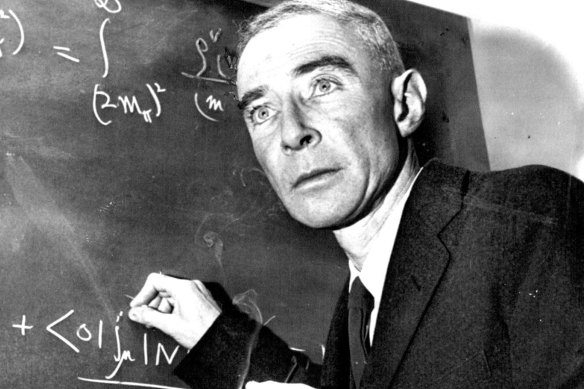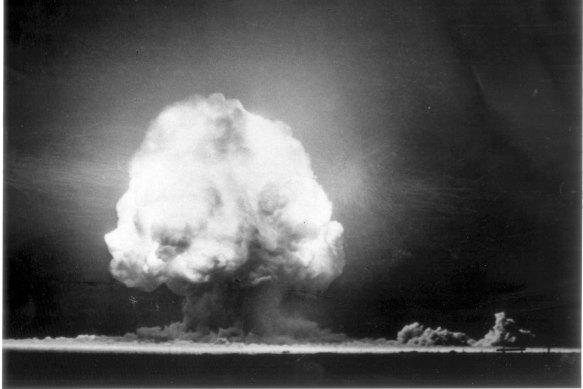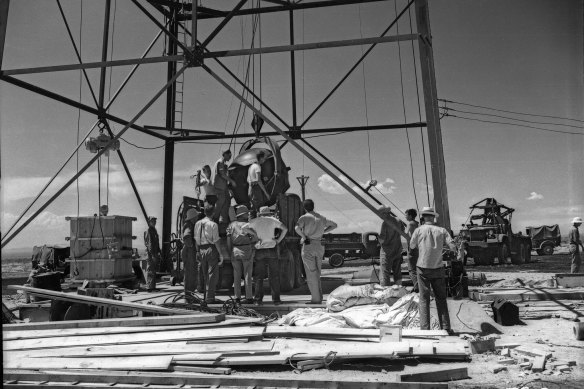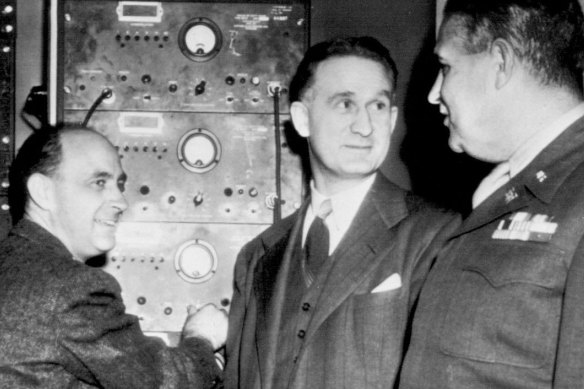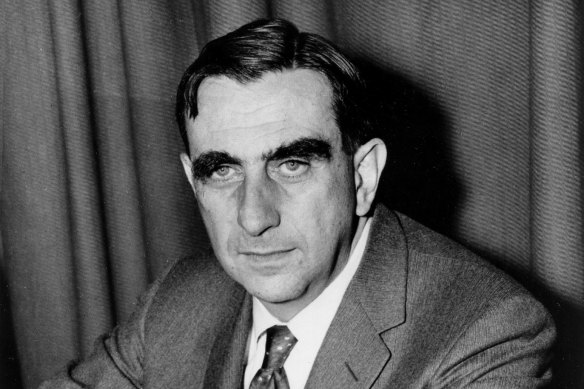‘Blown out of proportion’: How Robert Oppenheimer knew the atomic bomb test wouldn’t end the world
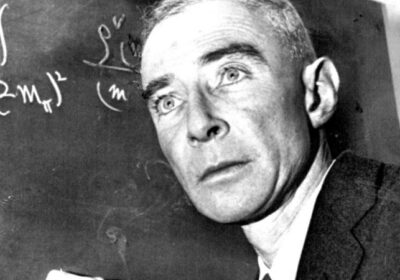
Save articles for later
Add articles to your saved list and come back to them any time.
In a chilling, existential, bizarrely comic moment, the new movie Oppenheimer revives an old question: Did Manhattan Project scientists think there was even a minute possibility that detonating the first atomic bomb on the remote plains of New Mexico could destroy the world?
The long, strange history of what came to be known as the “atmospheric ignition” scenario has been distorted over the years, and the movie distorts it further.
Dr Robert Oppenheimer in 1957.Credit: AP
The nightmarish idea was this: The tremendous fireball generated by the bomb is so great that it heats nitrogen atoms in the atmosphere to the point where their atomic cores, called nuclei, fuse. The energy released causes more nuclei to fuse, triggering a runaway reaction that sets the atmosphere ablaze.
And this is the way the world ends.
Except that it didn’t. And physicists knew it wouldn’t, long before the Trinity test on July 16, 1945, at the Alamogordo Bombing Range, about 210 miles (337 km) south of the secret Los Alamos, NM, laboratory.
“This thing has been blown out of proportion over the years,” said Richard Rhodes, author of the Pulitzer Prize-winning book The Making of the Atomic Bomb. The question on the scientists’ minds before the test, he said, “wasn’t, ‘Is it going to blow up the world?’ It was, ‘Is it going to work at all?’”
The “Trinity” test took place just before dawn in New Mexico on July 16, 1945.
In the movie, one scene has J. Robert Oppenheimer, director of laboratory, seeking to reassure his boss, General Leslie Groves, on the eve of the test.
Upon investigation, Oppenheimer tells him, physicists have concluded that the chances the test detonation will destroy the world are “near zero.” Realising the news has alarmed, not reassured, the general, Oppenheimer asks, “What do you want from theory alone?”
“Zero would be nice,” the general replies.
Oscar voters may decide next March that director Christopher Nolan made the correct dramatic choice. But no physicists or historians interviewed for this story recalled coming across any mention of such a conversation between Oppenheimer and the general in the historical record.
The Technical Area of the Los Alamos laboratory in January 1947.
“Did the actual exchange happen at that moment? No, I don’t think so,” said Alex Wellerstein, an associate professor at Stevens Institute of Technology in Hoboken, N.J., and author of the 2021 book, Restricted Data: The History of Nuclear Secrecy in the United States.
“But were there discussions like that? I believe so.”
The ultimate catastrophe?
At a conference in the summer of 1942, almost a full year before Los Alamos opened, physicist Edward Teller raised the possibility of atomic bombs igniting Earth’s oceans or atmosphere. According to Rhodes’s account, Hans Bethe, who headed the theoretical division at Los Alamos, “didn’t believe it from the first minute” but nonetheless performed the calculations convincing the other physicists that such a disaster was not a reasonable possibility.
Workers mounting the world’s first atomic device, dubbed “the Gadget,” to a test tower at the Alamogordo Bombing Range in New Mexico in July 1945.Credit: Los Alamos National Laboratory
“I don’t think any physicists seriously worried about it,” said John Preskill, a professor of theoretical physics at California Institute of Technology.
Still, the discussions and calculations persisted long after the Trinity test. In 1946, three Manhattan project scientists, including Teller, who would later become known as the father of the hydrogen bomb, wrote a report concluding that the explosive force of the first atomic bomb wasn’t even close to what would be required to trigger a planet-destroying chain reaction in air. The report was not declassified until 1973.
A 1979 study by scientists at the University of California’s Lawrence Livermore Laboratory examined the question of whether a nuclear explosion might trigger a runaway reaction in the atmosphere or oceans. In page after page of mathematical equations, the scientists described a complex set of factors that made atmospheric ignition effectively impossible.
Probably the easiest to grasp is the fact that, even under the harshest scenarios, far more energy would be lost in the explosion than gained, wiping out any chance to sustain a chain reaction.
In 1975 and 1976, the doomsday issue flared up again in the Bulletin of the Atomic Scientists when the journal published “The ultimate catastrophe,” a shocking essay by H.C. Dudley, a professor of radiation physics at University of Illinois Medical Centre in Chicago.
Dudley reported that during World War II, “eminent scientists” had offered President Franklin D. Roosevelt two options: either accept the possible slavery of the Nazis, they said, or develop and explode atomic bombs.
“There was a third option, however, that was kept under wraps, top secret, discussed only behind closed doors,” Dudley wrote. “This was the possibility of triggering a vast nuclear accident when and if a fission device was detonated.”
Dudley went on to explain that, in an interview with writer Pearl Buck published in 1959 in the American Weekly, Manhattan Project physicist Arthur H. Compton had acknowledged that there was a concern that Earth would be vaporised.
“It would be the ultimate catastrophe,” Buck quotes Compton as saying.
Dudley’s essay also recounted a story that on the day of the test, “as zero hour approached” General Groves was annoyed to find Manhattan Project physicist and Nobel Prize winner Enrico Fermi making bets with colleagues about whether the bomb would ignite the atmosphere, “and, if so, whether it would destroy only New Mexico ― or the entire world.” (Some experts have suggested Fermi’s actions may have been more of a joke, or an example of gallows humour.)
The Bulletin of the Atomic Scientists printed letters critical of the essay, then a full rebuttal from Bethe himself, in which the physicist quickly dismissed the idea that an atomic blast could ignite the atmosphere or ocean as “nonsense.” He wrote that “Buck had completely misunderstood” Compton.
Dr Enrico Fermi, (left), his associate, nuclear physicist Dr. Walter H. Zinn (centre), and Major General Leslie Groves, head of the Manhattan Engineering project in 1946.Credit: AP
Still, more than a decade later, Bethe found himself asked about the same issue in an interview published in Scientific American. “It is such absolute nonsense,” he repeated, “and the public has been interested in it . . . and possibly it would be good to kill it once more.”
What scientists are really saying
Fascination with this doomsday scenario may stem, at least in part, from a misunderstanding of what physicists mean when they say “near zero.” The branch of physics known as quantum mechanics, which deals with matter and light at the atomic and subatomic scale, does not rule out any possibilities.
For example, if a boy tosses a rubber ball at a brick wall, there is an exceedingly remote – but still valid – possibility that instead of watching the ball bounce back, he could see it pass through the wall.
Dr Edward Teller in 1958.Credit: AP
Aditi Verma, an assistant professor of nuclear engineering and radiological sciences at the University of Michigan, put it this way: “What a physicist means by ‘near zero’ would be zero to an engineer.”
In the 2000s, scientists encountered a similar problem of terminology as they prepared to generate high-speed particle collisions at the Large Hadron Collider in Geneva. Talk surfaced that the activity might generate a black hole that would devour Earth.
As outlandish as the notion was to many scientists, the nuclear research organisation CERN felt obliged to deal with the fear, noting on its website that “some theories suggest that the formation of tiny ‘quantum’ black holes may be possible. The observation of such an event would be thrilling in terms of our understanding of the Universe; and would be perfectly safe.”
In other words, any black hole created by the collider would be far too small to pose any risk to the planet.
Scientists say such disaster scenarios are sometimes the price of crossing new thresholds of discovery.
The discussions and calculations on the issue of atmospheric ignition were entirely appropriate given the situation and “encapsulates the fear of the unknown,” said Daniel Holz, a University of Chicago physics professor and co-chair of the board at the Bulletin of the Atomic Scientists that sets the Doomsday Clock.
“You don’t often talk in certainties,” he said. “You talk in probabilities. If you haven’t done the experiment, you are hesitant to say, ‘This is impossible. It will never happen.’ . . . It was good to think it through.”
Rhodes added that he hopes the Oppenheimer movie will not lead people to doubt the scientists on the Manhattan Project.
“They knew what they were doing,” he said. “They were not feeling around in the dark.”
Washington Post
Get a note directly from our foreign correspondents on what’s making headlines around the world. Sign up for the weekly What in the World newsletter here.
